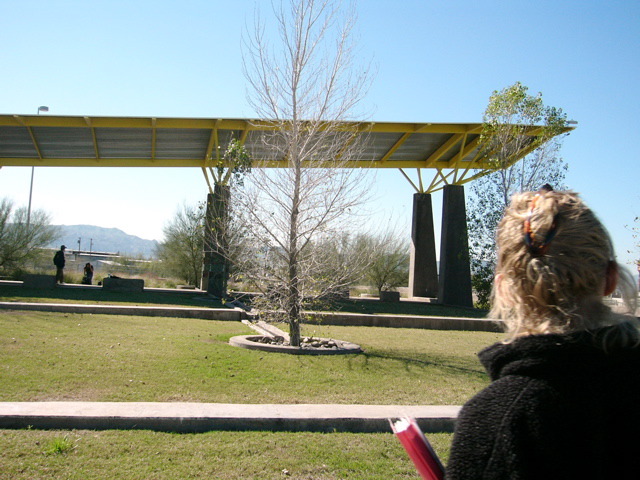|
|
|
| Chris Brown's Project Pages
|
Nature in the City By Chris Brown Nobody wants to live in a big, ugly, dirty mass of concrete and metal, but how about a growing, vibrant community with open space and preserved wildlife habitat? This is the dichotomy that could easily be presented by developers of South Phoenix, or South Mountain Village, in the next few years. With the creation of the Rio Salado Project, nearby South Mountain Park, and new subdivisions with strategically placed open spaces and small parks, South Phoenix has the ability to advertise itself as an environmentally friendly place with all the visual and practical advantages of less densely urbanized areas. The real question people should be asking, however, is whether this advertised image matches the reality of South Mountain Village, and whether the actual place is really what we want and need.
The Rio Salado Project is designed to rehabilitate the Salt River bed in South Phoenix, transforming a dilapidated and uninspiring river bottom into an environmental safe-haven complete with reconstructed wildlife habitat, an environmental education center, and plenty of passive recreational activities. As Carol Sowers reports in the Arizona Republic in December of 2004, recent appropriation from the federal government has kept the project on track, feeding the flame of expectation on the city government’s mind. This project is meant to revitalize the underdeveloped and largely forgotten South Phoenix by injecting a fun and visually appealing center for family and economic activity. While many dispute the projected environmental advantages of the project, the beautification aspect is hard to refute, and the impact the project will have in helping bring residents to South Phoenix is undeniable. When looking at the changes occurring in the area, however, one might begin to question the motives of those in charge of development. Bringing people to South Phoenix seems like a great idea, except that people already live in South Phoenix. What the planners really seem to want is to bring middle class families and professionals, with their full pocketbooks and SUVs, into an area that has received a lot of bad press and talk in the past decades. The Rio Salado Project is one way to help accomplish that goal, acting to brush away the old image of South Phoenix, replacing it with a new and better image of South Mountain Village. New housing developments all have their grassy front yards, small parks with trees, and open areas, all projecting an image of being just far enough away from the city that we can all live there happily. Real problems, however, may be just under the surface. South Phoenix has received a lot of bad press about its poverty and violence, but even more disturbing to some are the environmental problems in the area. Many industries are located in the vicinity, spewing toxic chemicals and dangerous materials into the air where poor and powerless people have historically lived. Bob Bolin and his co-authors of “Environmental equity in a sunbelt city: the special distribution of toxic hazards in Phoenix, Arizona” conclude from a scholarly study “that there is a clear pattern of environmental inequity in Phoenix.” The cheap land near the city, containing few residents who might be able to successfully fight the opening of an industrial facility, has attracted many of these polluters. Now that the city is determined to change the socio-economic status of the area, it will be interesting to see how these forces interact. Part of a conceivable smoke screen put forward to distract new home buyers are the Rio Salado Project and the open spaces in new subdivisions. Many people have chosen to buy homes in South Phoenix, but the question still remains as to the completeness of their knowledge of the area. In a few years, however, as people with more money and social power move into the area and as word of these industries gets out to more people, pressure from residents will force these industries to move to cheaper land further away from the city. What will be left is a community with a large amount of fake nature. The parks and open areas in new housing developments give some of the aesthetic pleasure of being around nature, as does the Rio Salado Project and South Mountain Park, but how much of nature will actually be in the area? Rio Salado will have some restored habitat for small animals, and South Mountain Park is big enough to pass as nature to many people, but nothing more significant sets South Mountain Village apart from any other close suburb of Phoenix, or any other major city for that matter. In twenty years, after the hype and excitement of a new suburb die away, we will be left with just another place to live. Sure, planners made an attempt to make the place look and feel better, but for what purposes? If we really wanted to make a community where nature was alive and fit in without major problems, we would be able to. If we set our minds to it, we could learn from the mistakes and failed attempts of previous developments. Unfortunately, the sense you get from the development of South Phoenix is that the nature is not real. It is placed there to serve a purpose: to get middle class people tired of a sprawling city in a harsh desert to move to a historically poor and downtrodden area. Maybe this is a valid purpose, but all it will leave us with is an empty feeling that we could have done better. Just as cities around the world “redevelop” areas that have fallen out of style, Phoenix is redeveloping South Phoenix into South Mountain Village. I wonder, however, how long it will be until South Mountain Village is redeveloped into “Mountain Shadows” or some other equally tritely named community because we did not get it right the first time.
|

